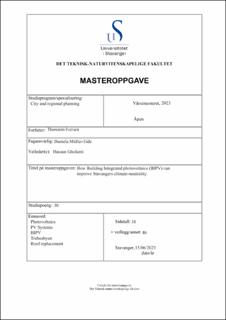| dc.description.abstract | This Master Thesis is a study on how replacing regular roof materials in Stavanger could contribute towards becoming a climate-neutral city. It will look at pros and cons of replacing the already existing roofing in Stavanger, with regards of both materials, energy production, energy consumption and feasibility. Furthermore, the study will evaluate challenges with regards to laws and regulation set by governing parties in Stavanger, especially in the area nicknamed “Trehusbyen” which is the largest cluster of wooden houses in Europe. The regulations and rulesets of both design and material usage here is very strict and can quickly become an obstacle to implement Building Integrated Photo Voltaics in the area.
Global warming and greenhouse gas emissions have become a major issue the past years, organizations like the United Nations and the European Commission have established several guidelines as to how counteract this. Moving towards a non-carbon-based energy mix is a step towards the right direction, and through renewable energy sources as solar power is essential to achieve the goals set. Additionally, given the current war in Ukraine and how the current energy market has developed, it is also key to move away from a single entity providing the energy and to a decentralized and local energy production system. Stavanger is the energy capital of Norway due to its massive oil trade and was selected in 2022 to be one of 112 cities that collaborates with the European Union for climate-neutrality and smart cities.
PV systems is a way to harvest energy from the sun by absorbing the radiation from the sun and is somewhat independent with regards to the local climate. Their design enables them to produce energy in both warm and cold climates, and even the reflections from neighboring buildings provide enough to keep it producing. The panels currently on the market is made of Si-cells, which occupies more than 80 % of the current market with an effect of 20 - 25 %. PV systems can be categorized into three different types, BAPV, which are attached to buildings by a frame, BIPV, which replaces building materials with PV systems, and IIPV, which are PV systems integrated into infrastructure. It is important to note that EU produced PV systems have a much smaller carbon footprint than Chinese produced, even though they do not differ too much when comparing how long they have to produce to reach their lifecycle imprint. As Stavanger has the largest cluster of wooden houses in Europe, some very strict regulations and rules are set up to keep the area as preserved to the original as possible. Thus, the only plausible solution to set up PV systems on roofs in the area is to use BIPVs which match the current esthetics of what already exists.
Even though the local climate in Stavanger experiences frequent rain, the temperature is stable throughout all seasons. PV systems are designed in a way that makes them usable in both cold and warm climates, and their internal processors perform better in colder climates. It is usually recommended with some type of ventilation for the system when placed on the roof, but the colder climate gives an automatic cooling option. The rain will also help clean the panels from dirt and other particles blocking the panels, and with a warmer coastal climate, snow is not too frequent and will not block the panels either. Although PV systems provides opportunities to become climate-neutral, they create an issue with regards to fire safety. In Norway, there are few firemen with experience on handling fires in buildings with PV systems on the roof, few know about the special equipment required to safely handle it, and there are no standards or guidelines as to how deal with them. This issue must be solved if the potential of replacing roofs with integrated solutions are to go through, as the risk of fires are higher than if they were just attached.
There are other cities and countries exploring the option as is discussed in this thesis, for example Cyprus has done research to replace their mostly import carbon-based energy by utilizing PV systems installed on the roofs. They found that by replacing 70 % of roofs with PV systems on residential buildings with a 3 kW PV system, they could cover 100 % of the domestic sectors energy demand. Although Cyprus is the area in Europe with the highest potential for solar power production, they experience more heat than in Stavanger, which also reduces the effectivity of the panels. This shows that there are potential for other areas as well, if they keep up with the district-based solutions instead of doing it on smaller scale.
To ensure a proper societal gain for the project, only buildings above 500 square meters will be considered, as individual solutions are not only expensive, but also unpractical when the surplus is only used for storage. For a good flow of the produced energy from the system, it is essential to focus on bigger systems that provide for larger areas rather than single instances, so the overflow of eventual energy produced can be shared throughout the district. In total there are 2263 buildings in Stavanger that meats these requirements and can be considered to have their roofs replaced. A set of assumptions made by Multiconsult has been done to simplify, both with regards to time and practicality, to find the total potential roof area utilizable.
The calculations show that by fitting these buildings with BIPVs, Stavanger would be able to replace a third of their household energy consumption with the produced energy. If combining these with other energy saving measures, this number could increase a lot. Additionally, if one were to fit other areas not included in this thesis, such as land-based PV systems on areas that either no longer are in use, or other available areas, this would further increase the potential of Stavanger. | |
